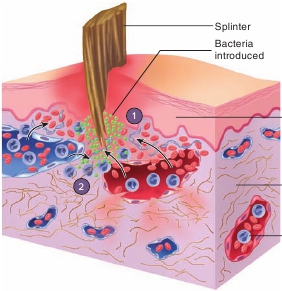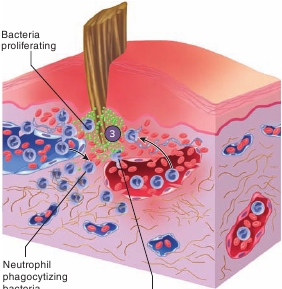CHAPTER 4 Tissues
133

1
A splinter in the skin causes damage andintroduces bacteria. Chemical mediators ofinflammation are released or activated in injuredtissues and adjacent blood vessels. Some bloodvessels rupture, causing bleeding.
Epidermis
2
Chemical mediators cause capillaries to dilateand the skin to become red. Chemical mediatorsalso increase capillary permeability, and fluidleaves the capillaries, producing swelling
(arrows).
Dermis
Bloodvessel

3
White blood cells (e.g., neutrophils) leave thedilated blood vessels and move to the site ofbacterial infection, where they begin tophagocytize bacteria and other debris.
bacteria
PROCESS FIGURE 4.7
Stages of the
Inflammatory Response
Neutrophilmigrating throughblood vessel wall
growth ceases, but they retain the ability to divide and arecapable of regeneration in response to injury.
Permanent cells
have a very limited ability to replicate and, if killed, are usuallyreplaced by a different type of cell. Some permanent cells, suchas neurons, are postmitotic. If damaged, neurons may recoverif the cell body is not destroyed; however, if the neuron cellbody is destroyed, the remainder of the neuron dies. Someundifferentiated cells of the central nervous system are stemcells that can undergo mitosis and form functional neurons inthe adult. This has raised hope that damaged areas of the brain
may be regenerated. Undifferentiated cells of skeletal andcardiac muscle also have a very limited ability to regeneratein response to injury, although individual skeletal and cardiacmuscle cells can repair themselves. In contrast, smooth musclereadily regenerates following injury.Skin repair is a good example of tissue repair (figure 4.8). Thebasic pattern of repair is the same as for other tissues, especiallythose covered by epithelium. If the edges of the wound are closetogether, as in a surgical incision, the wound heals by a processcalled
primary union,
or
primary intention
. If the edges are not